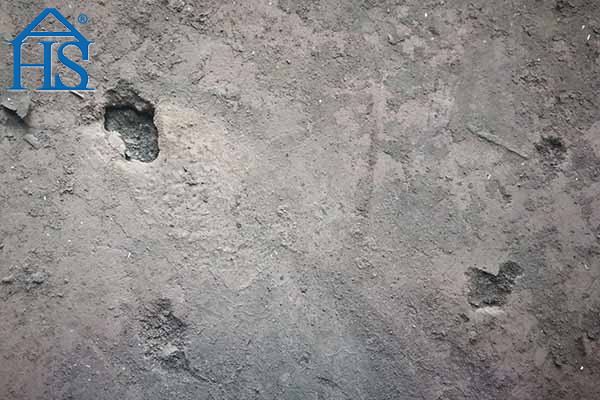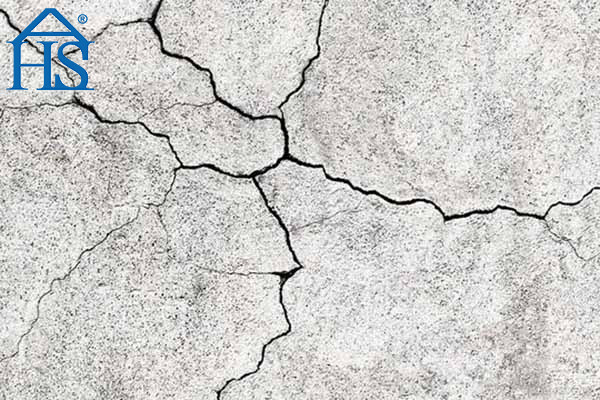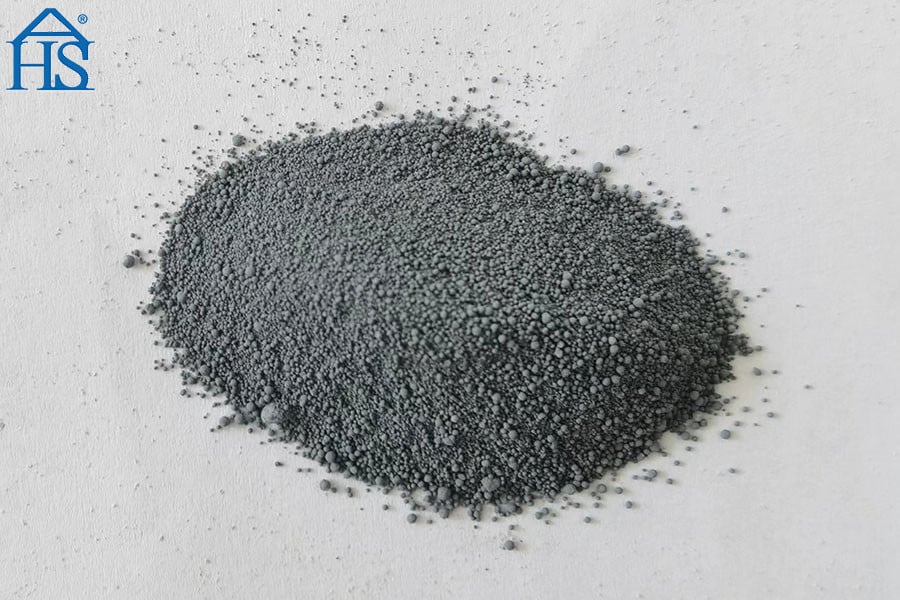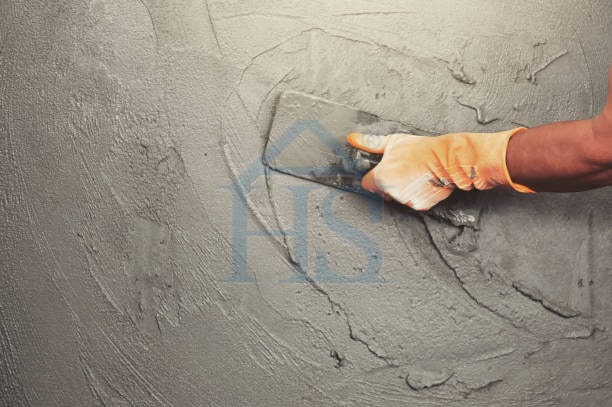Common Causes of Ground Dusting
1. Excessive water-cement ratio of the cement mortar (excessive mortar consistency) reduces the strength of the plastering layer.
The larger the water-cement ratio is, the lower the strength of cement mortar is. Therefore, excessive water consumption during construction will greatly reduce the strength of mortar, and loose cement mortar will appear on the surface after operation.
2. Factors such as failure to understand the basic principle of cement hardening, improper process arrangement, and too dry or too wet bottom layer cause the ground calendering to be too early or too late.
2.1 If the calendering is carried out too early, the hydration of cement has just begun, the gel has not yet been fully formed, and there is still more free water. There will also be floating water on the surface, which is not conducive to eliminating surface pores and bubbles and reducing the strength of the cement mortar surface.
2.2 If the calendering is carried out too late, the cement has finally set and hardened, and the surface is dry. The pores and trowel marks of the cement mortar surface layer cannot be eliminated, and the hardened surface will be disturbed, which greatly reduces the strength and anti-wear capacity of the surface layer, and the surface layer is easy to sand. If the surface has been finally set and hardened, it will be watered and pressed by force, which will cause damage to the cement surface structure, reduce the strength, and easily lead to roughing.
2.3 The cement mortar shall be smoothed and flattened the initial setting and before the final setting (before the concrete surface is pressed by hand with pits and does not stick), which is an important step to ensure the compactness of the concrete surface, improve the concrete surface strength and prevent the concrete surface from roughing.
2.4 The calendering shall be carried out not more than 3 times, generally two times is enough. While in adverse conditions, such as the construction of cement floors in winter, it is appropriate to be formed at one time, and the mortar should get drier.
2.5 In order to meet the requirements of calendering after the initial setting and before the final setting of cement, a certain time interval must be set between the initial setting and the final setting of cement. If the time interval is too short, in some large projects, the one-time construction of cement floor is often very large, in order to complete the surface layer of cement floor in a short time, polishing, and calendering, often can not be done.
3. Therefore, after the concrete floor is poured, the appropriate calendering time shall be selected. The opportunity for surface plastering shall be chosen according to factors such as concrete strength grade, temperature, and humidity. Therefore, it is necessary to choose the right time to press the concrete surface. Early compaction will make the concrete surface uneven and cracked, and late compaction will make the surface uneven and shiny.
4. Improper curing. After the completion of the cement floor, the water will evaporate rapidly in a dry environment if the curing days are not enough. When the cement is in the hardening stage, the hydration of the cement will continue and go deep into the cement particles. The deeper the hydration, the higher the strength of the cement mortar. The hydration of cement is affected due to the lack of water during hydration, which will slow down the hardening speed or even stop hardening, resulting in the dehydration of cement mortar and affecting the strength and wear resistance. In addition, watering the ground too early will also lead to large-area peeling, sand leakage, and dustingafter use.
5. The cement floor is used too early and the finished products are not well protected. If people walk on the cement floor or carry out the next process before the strength of the cement ground mortar does not reach a certain strength, the ground will be dustcaused by friction.
6. Freezing damages. Freezing damage will be caused by construction in winter without closed doors and windows or heating equipment. Cement mortar flooring may be damaged by freezing and loose particles will be formed, leading to dustingand peeling.
7. The newly plastered ground is not used properly in winter. In winter, a fire is built in the newly made cement floor room for heating up. The carbon dioxide gas generated during combustion is harmful. After contactingthe cement mortar surface, it will react with the calcium hydroxide that has not yet crystallized and hardened the cement to generate calcium carbonate. It will hinder the normal hydration of the cement within the cement mortar, and reduce significantly the strength of the ground surface layer, often resulting in ground dusting.
8. Raw materials do not meet the requirements
9. Cement with low strength or use of expired, dampened,or lumped cement, which has low activity will seriously reduce the strength and wear resistance of the surface layer.
10. The sand contains a large amount of mud. If the mud content of the ground sand exceeds 10%, the strength of ground surface layer will decrease by 20-50%, and the bonding force will be poor, resulting in ground roughing.
11. As the sand particle size is too fine, the sand surface area is large, and the water requirement is large when mixing, the water-cement ratio will increase and the strength will be reduced.
Hollowing of Cement Mortar Flooring

- The base course is not clean and too smooth. In the process of decorative construction, the roof and walls are generally constructed first, followed by the flooring. Therefore, during the construction of flooring, there are floating plaster film and other construction dirt on the base course, especially the lime mortar of indoor painting, which is sticky and dirty on the floor slab and extremely difficult to clean. These surface floating ash seriously affect the bond between the base and the surface courses. As the surface of the base course is too smooth, the concrete surface treatment is not flat and rough enough during the cast-in-place reinforced concrete floor slab pouring and tamping process, resulting in insufficient bonding force between the base course and the surface course and hollowing of the surface course.
- The base course surface is too dry or is waterlogged. As the base course surface is too dry, the mortar will lose water too fast and the strength is not high after the mortar is laid, the base course surface will absorb a powder layer, which plays the role of isolation between the surface and the base courses, resulting in poor bonding between the base course and the surface course, thus resulting in hollowing.
- During the construction of cement mortar flooring, a layer of plain cement mortar is generally applied on the base course. If it is applied too early during the operation, the applied mortar will be air-dried and hardened, which will not only increase the bonding force, but also play an isolating role between the base course and the surface course. If dry cement is sprayed first and then the construction is carried out by the sweeping mortar method, it will lead to uneven mortar wet and dry, which is one of the hidden dangers leading to the hollowing of cement flooring.
Main Causes of Cement Mortar Flooring Cracking
The main reason is that the floor area is large and the volume of cement shrinks too much during hardening.
- The cement used has poor stability or the hot cement just grinded. The cement used has a large amount of shrinkage during setting and hardening. Different types or grades of cement are used onthe same floor, and the surface cracks are caused by different settings and hardening times and shrinkage during setting and hardening.
- The particle size of sand is too fine or the mud content is too large. The finer the particle size of the sand, the larger the surface area, and the greater the amount of cement paste adsorbed on the surface of the sand will increase accordingly. Therefore, the strength of cement mortar will be reduced under the condition of unchanged cement consumption. Moreover, the mud content in the sand is too large, and the volume of the soil in the cement mortar will shrink during the hardening and dehydration process, resulting in the cracking of the floor surface.
- The hydration will continue after the final set of cement mortar due to untimely curing or no curing. In the season with high temperature and dry air, dry shrinkage cracks will appear on the cement surface course if the curing is not carried out in time or without curing.
- If the tensile strength of the cement mortar is reduced due to excessive dilution or uneven mixing of the cement mortar, once the overall surface of the cement mortar is subjected to tensile stress, the cement surface cracking will occur.
- The backfill is of poor quality. Poor soil quality or improper tamping and filling of backfilling soil will cause uneven subsidence and cracks on the ground surface after the completion of the ground surface course. If there is no construction joint left on a large area of ground and the structure is deformed, the ground surface course will crack.





